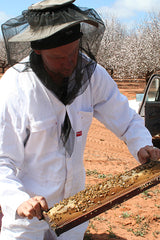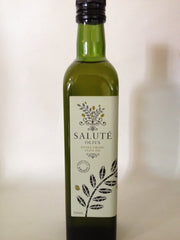Ingredients
Beeswax
 Beeswax is a treat for the senses. It is beautiful to see as honeycomb in the hive and as a golden ingot once rendered. It smells delicious and is warm and silken to touch. This amazing natural substance is rich in vitamin A, has antiseptic and anti-inflammatory properties, and it provides a protective yet breathable barrier to the skin against the sun, cold, wind and pollutants. Burning as a candle, beeswax purifies the air we breathe by producing negative ions that clean the air of odours, dust and other allergens. It is not surprising that beeswax has been prized by humans for more than 5000 years.
Beeswax is a treat for the senses. It is beautiful to see as honeycomb in the hive and as a golden ingot once rendered. It smells delicious and is warm and silken to touch. This amazing natural substance is rich in vitamin A, has antiseptic and anti-inflammatory properties, and it provides a protective yet breathable barrier to the skin against the sun, cold, wind and pollutants. Burning as a candle, beeswax purifies the air we breathe by producing negative ions that clean the air of odours, dust and other allergens. It is not surprising that beeswax has been prized by humans for more than 5000 years.
The brilliantly engineered and iconic hexagonal honeycomb is constructed by young female worker bees as chambers for honey storage and for raising brood in the hive. The wax is produced through the conversion of honey into wax, which is then secreted as small scales through the wax glands on the abdomen. It is estimated that it takes six times as much honey by weight to produce one unit of beeswax. This means the honeybees must eat six kilograms of honey to produce one kilogram of wax. It takes 4000 bees about three weeks to collect six kilograms of honey, making beeswax precious not only for its inherent properties, but also for the sheer labour involved in its production.
Extra Virgin Olive Oil

According to the Australian Slang Dictionary, the Good Oil is useful information, a good idea, the truth. According to us, the Good Oil is definitely Extra Virgin Olive Oil. The Mayo Clinic confirms that the monosaturated fatty acids (the fat) in olive oil are actually a healthy fat, contributing to lowered risk of heart disease and lowered cholesterol levels. Add to this its antioxidant and anti-inflammatory polyphenols and its vitamin E content and you can start to understand the importance of olive oil in the human diet over at least the past 5000 years.
Anything as good to eat as olive oil can only be good as a topical application for the skin. And the olive oil we source from Salute Oliva is the best quality, certified organic, unrefined, cold pressed extra virgin oil. We do eat it and highly recommend it to you.
Vanilla
Vanilla is one of the most exclusive spices in the world, largely due to the intensity of human labour involved in hand pollinating and hand harvesting. It is prized for its unique aroma and is widely used in food and skin care products. de'bee sources bourbon vanilla pods from an Australian importer with grower partnerships in Indonesia and Madagascar. The pods are split before infusing in olive oil, ready for making delicious Pucker Up vanilla lip balm.
Honey
Honey is simply divine. It has antibacterial and antimicrobial properties, is a raw food and is amazingly tasty. Modern beekeeping methods mean it can be harvested without harming the bees, and anyone who has had the opportunity to sample it straight from the hive knows just how natural it is. We are fortunate to have our own suburban hives from which we harvest local flora honey for our Pucker Up honey lip balm, and of course for our own eating.
Plant Extracts
The following information is adapted from the authoritative Salvatore Battaglia (2003). The Complete Guide to Aromatherapy. Brisbane: The International Centre of Holistic Aromatherapy.
Atlas Cedarwood (Cedrus atlantica)
This essential oil is distilled from wood chips from the Atlas Cedar tree, and is used for stress, anxiety and tension, in addition to treating coughs and bronchial infections. It is also recommended for the treatment of skin and scalp conditions such as dandruff and acne. As an aromatherapy oil it has a strengthening and comforting effect, creating balance.
Calendula (Calendula officinalis)
Calendula-infused oil has been traditionally used to treat skin conditions, varicose veins, and assist in the healing of wounds. Native to the Mediterranean, Calendula has antibacterial and anti-inflammatory properties which are extremely useful for treating minor burns (including sunburn), insect bites, eczema, and for promoting blood supply to body tissue.
Chamomile (Matricaria recutita)
Commonly used as a soothing tea to aid digestion and for its calming sedative effect, German Chamomile is also especially useful in the treatment of dry or itchy skin conditions such as eczema. As one of the gentlest essential oils, it is highly beneficial for treating children. With anti-inflammatory properties, Chamomile is effective in the treatment of muscular aches and pains, sprains, and inflamed and painful joints. Applied topically in massage or rubbed into the skin, Chamomile is known to promote relaxation, alleviates insomnia and can even assist with headaches.
Eucalyptus (Eucalyptus radiata or Eucalyptus camaldulensis)
Eucalyptus oil is probably one of the most commonly known (and used) essential oils, with a history dating back to the mid-1800s, when Eucalytus radiata (Narrow-leaf Peppermint) was first distilled by Joseph Bosisto in Melbourne. Its most common uses are as an antiseptic and a decongestant/expectorant, both of which are excellent in the treatment and control of colds and congestion. It is also effective in treating headaches, muscular aches and pains and rheumatic discomfort. It can be applied directly (in carrier oil) such as in massage, or used as an inhalation such as in a bath or a vapouriser. Eucalyptus has also been found to improve mood and revive the spirits. Many varieties of Eucalyptus are distilled into oil, such as E.globulus, E. smithii, E. radiata, E. camaldulensis, E. staigeriana and the very closely related Corymbia citriodora .
Lavender (Lavandula angustifolia)
Lavender has long been used in massage and as a vaporised essential oil to promote relaxation and relieve nervous tension and anxiety. Used to relieve rheumatic, sciatic, arthritic and menstrual pain, Lavender is also useful in the treatment of headaches and migraines, insomnia and to uplift the spirits of those feeling stressed or depressed.
Lavender can act both as an insect repellent, and to soothe insect bites. With antibacterial qualities, it is also useful for sunburn and skin conditions such as eczema, psoriasis, dermatitis and minor wounds.
Mandarin (Citrus reticulata)
Mandarin oil is considered to aid digestion and relieve stomach upsets, especially in babies and children. It is a soothing oil, useful for combating restlessness and improving mood.
Myrrh (Commiphora myrrha)
Myrrh is extracted from the resin of the myrrh bush, and is one of the oldest known aromatic substances, dating back at least 4000 years. Reputed to promote youthfulness, it was used by Egyptian women in facial preparations to preserve the complexion.
Now commonly used in the treatment of bronchial conditions, Myrrh is an expectorant, with astringent and antimicrobial properties. It is also considered useful in treating the nervous system, helping to alleviate stress and worry and promote inner calm.
Peppermint & Menthol (Mentha piperita)
Peppermint is a very commonly used oil, sought after for its medicinal properties for many centuries. With a cooling effect on mucous membranes, peppermint is particularly effective as a decongestant and to fight inflammation and infection.
Applied topically as a liniment, peppermint is useful for treating muscular pain, lumbago and insect bites, with a local anaesthetic effect which helps to relieve skin irritation and itching.
Peppermint taken internally, such as in a tea, is highly effective in treating digestive complaints, relieving nausea and vomiting, stomach pains, diarrhoea and even travel sickness. It acts on the lymphatic system to stimulate blood flow and regeneration.
Additionally peppermint oil assists with concentration and mental fatigue, stimulating circulation, calming the nerves and relieving tension headaches and migraines.
Tangerine (Citrus reticulata blanco var. 'tangerine')
Very similar to the Mandarin, Tangerine oil is cold-pressed from the peel of the fruit, and is used as a pleasant citrus flavouring. It has a sedative effect and can be effective in aiding and calming digestion, and can also be very useful in the treatment of acne.
Tea-tree (Melaleuca alternifolia)
Another Australian plant, tea-tree was used by Australian aborigines to relieve headaches long before European settlement. The name tea-tree came about in 1777 when Captain Cook used the leaves to make a tea to prevent scurvy. Distillation came much later in the 1920s, when the many properties of this oil were discovered. The oil acts as an antimicrobial against bacteria, viruses and fungi, and acts as an immunostimulant when the body is threatened with infection. It is recommended for people suffering from glandular fever or other illnesses to assist recovery and build the immune system. Most commonly, it is used for its antibacterial and decongestant properties, similar to eucalyptus oil and is very useful for those suffering from bronchial, asthmatic or other respiratory complaints.
Tea-tree is also recommended for treating skin complaints such as acne, fungal infections, cold sores, dandruff, blisters, burns and cuts. It is one of few essential oils which can safely be used without a carrier oil. It helps to eliminate harmful pathogens and prevent recurrent infections.
